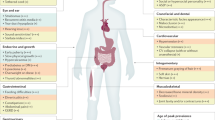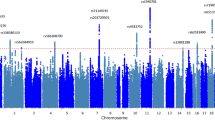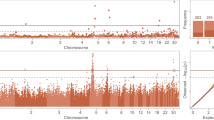Abstract
The Williams-Beuren syndrome (WBS) is a complex developmental disorder with multisystemic manifestations including supravalvular aortic stenosis (SVAS), a so-called elfin face, a hoarse voice, and a specific cognitive phenotype. Most WBS patients have a >1 Mb deletion on one of their chromosomes 7 in q11 but except for elastin, whose haploinsufficiency causes the cardiovascular malformations, it is unknown which genes in the deletion area contribute to the phenotype. We have investigated a family with a cytogenetically balanced translocation t(7;16)(q11.23;q13) in which affected individuals manifested a broad spectrum of clinical phenotypes ranging from a hoarse voice as the only feature to the full WBS phenotype. Molecular cytogenetic and DNA sequence analyses of the translocation breakpoint showed that the cytogenetic rearrangement disrupts the elastin gene locus within intron 5 in the exact same manner in all translocation carriers. The recently described large inversion of the 7q11.23 region was not present in this family. Our data demonstrate that disruption of the elastin gene by a translocation breakpoint may cause classical WBS, atypical WBS, SVAS, or no recognisable phenotype, and provide a clear example for extensive phenotypic variability associated with a position effect in humans.
Similar content being viewed by others
Log in or create a free account to read this content
Gain free access to this article, as well as selected content from this journal and more on nature.com
or
References
Williams JCP, Barratt-Boyes BG, Lowe JB . Supravalvular aortic stenosis Circulation 1961 24: 1311–1318
Beuren AJ . Supravalvular aortic stenosis: a complex syndrome with and without mental retardation Birth Defects 1972 5: 45–56
Francke U . Williams-Beuren syndrome: genes and mechanisms Hum Mol Genet 1999 8: 1947–1954
Peoples R, Franke Y, Wang YK et al. A Physical Map, Including a BAC/PAC Clone Contig, of the Williams-Beuren Syndrome-Deletion Region at 7q11.23 Am J Hum Genet 2000 66: 47–68
Perez Jurado LA, Wang YK, Peoples R et al. A duplicated gene in the breakpoint regions of the 7q11.23 Williams-Beuren syndrome deletion encodes the initiator binding protein TFII-I and BAP-135, a phosphorylation target of BTK Hum Mol Genet 1998 7: 325–334
Nickerson E, Greenberg F, Keating MT, McCaskill C, Shaffer LG . Deletions of the elastin gene at 7q11.23 occur in approximately 90% of patients with Williams syndrome Am J Hum Genet 1995 56: 1156–1161
Perez Jurado LA, Peoples R, Kaplan P, Hamel BC, Francke U . Molecular definition of the chromosome 7 deletion in Williams syndrome and parent-of-origin effects on growth Am J Hum Genet 1996 59: 781–792
Brondum-Nielsen K, Beck B, Gyftodimou J et al. Investigation of deletions at 7q11.23 in 44 patients referred for Williams-Beuren syndrome, using FISH and four DNA polymorphisms Hum Genet 1997 99: 56–61
Fryssira H, Palmer R, Hallidie-Smith KA et al. Fluorescent in situ hybridisation (FISH) for hemizygous deletion at the elastin locus in patients with isolated supravalvular aortic stenosis J Med Genet 1997 34: 306–308
Hou JW, Wang JK, Wang TR . FISH analysis in both classical and atypical cases of Williams-Beuren syndrome Zhonghua Min Guo Xiao Er Ke Yi Xue Hui Za Zhi 1998 39: 398–403
Mila M, Carrio A, Sanchez A et al. Clinical characterization, molecular and FISH studies in 80 patients with clinical suspicion of Williams-Beuren syndrome Med Clin (Barc) 1999 113: 46–49
Dutly F, Schinzel A . Unequal interchromosomal rearrangements may result in elastin gene deletions causing the Williams-Beuren syndrome Hum Mol Genet 1996 5: 1893–1898
Urban Z, Helms C, Fekete G et al. 7q11.23 deletions in Williams syndrome arise as a consequence of unequal meiotic crossover Am J Hum Genet 1996 59: 958–962
Bellugi U, Bihrle A, Jernigan T, Trauner D, Doherty S . Neuropsychological, neurological, and neuroanatomical profile of Williams syndrome Am J Med Genet Suppl 1990 6: 115–125
Osborne LR . Williams-Beuren syndrome: unraveling the mysteries of a microdeletion disorder Mol Genet Metab 1999 67: 1–10
Mervis CB, Robinson BF, Bertrand J et al. The Williams syndrome cognitive profile Brain Cogn 2000 44: 604–628
Morris CA, Mervis CB . Williams Syndrome and related disorders in Lander E (ed) Annual Review of Genomics and Human Genetics Palo Alto: Annual Reviews 2000 pp. 461–484
Tassabehji M, Metcalfe K, Donnai D et al. Elastin: genomic structure and point mutations in patients with supravalvular aortic stenosis Hum Mol Genet 1997 6: 1029–1036
Metcalfe K, Rucka AK, Smoot L et al. Elastin: mutational spectrum in supravalvular aortic stenosis Eur J Hum Genet 2000 8: 955–963
Hammerer I, Gassner I, Muller W . Familiar occurrence of Elfin's face (Williams-Beurens Syndrome=wbs) and supravalvular aortic stenosis (=svas) (author's transl) Klin Padiatr 1979 191: 287–292
Osborne LR, Li M, Pober B et al. A 1.5 million-base pair inversion polymorphism in families with Williams-Beuren syndrome Nat Genet 2001 29: 321–325
Lichter P, Boyle AL, Cremer T, Ward DC . Analysis of genes and chromosomes by nonisotopic in situ hybridization Genet Anal Tech Appl 1991 8: 24–35
Bender K, Grzeschik KH . Possible assignment of the glyoxalase I (GLO) gene to chromosome 6 using man-mouse somatic cell hybrids Hum Genet 1976 31: 341–345
Saiki RK, Gelfand DH, Stoffel S et al. Primer-directed enzymatic amplification of DNA with a thermostable DNA polymerase Science 1988 239: 487–491
Altschul SF, Gish W, Miller W, Myers EW, Lipman DJ . Basic local alignment search tool J Mol Biol 1990 215: 403–410
Monaco AP, Bertelson CJ, Middlesworth W et al. Detection of deletions spanning the Duchenne muscular dystrophy locus using a tightly linked DNA segment Nature 1985 316: 842–845
Vortkamp A, Gessler M, Grzeschik KH . GLI3 zinc-finger gene interrupted by translocations in Greig syndrome families Nature 1991 352: 539–540
Wirth J, Wagner T, Meyer J et al. Translocation breakpoints in three patients with campomelic dysplasia and autosomal sex reversal map more than 130 kb from SOX9 Hum Genet 1996 97: 186–193
von Dadelszen P, Chitayat D, Winsor EJ et al. De novo 46,XX,t(6;7)(q27;q11;23) associated with severe cardiovascular manifestations characteristic of supravalvular aortic stenosis and Williams syndrome Am J Med Genet 2000 90: 270–275
Curran ME, Atkinson DL, Ewart AK et al. The elastin gene is disrupted by a translocation associated with supravalvular aortic stenosis Cell 1993 73: 159–168
Morris CA, Loker J, Ensing G, Stock AD . Supravalvular aortic stenosis cosegregates with a familial 6; 7 translocation which disrupts the elastin gene Am J Med Genet 1993 46: 737–744
Bedell MA, Jenkins NA, Copeland NG . Good genes in bad neighbourhoods Nat Genet 1996 12: 229–232
Felsenfeld G, Boyes J, Chung J, Clark D, Studitsky V . Chromatin structure and gene expression Proc Natl Acad Sci USA 1996 93: 9384–9388
Roessler E, Belloni E, Gaudenz K et al. Mutations in the human Sonic Hedgehog gene cause holoprosencephaly Nat Genet 1996 14: 357–360
Belloni E, Muenke M, Roessler E et al. Identification of Sonic hedgehog as a candidate gene responsible for holoprosencephaly Nat Genet 1996 14: 353–356
Fantes J, Redeker B, Breen M et al. Aniridia-associated cytogenetic rearrangements suggest that a position effect may cause the mutant phenotype Hum Mol Genet 1995 4: 415–422
Liu M, Parker RM, Darby K et al. GPR56, a novel secretin-like human G-protein-coupled receptor gene Genomics 1999 55: 296–305
Zendman AJ, Cornelissen IM, Weidle UH, Ruiter DJ, van Muijen GN . TM7XN1, a novel human EGF-TM7-like cDNA, detected with mRNA differential display using human melanoma cell lines with different metastatic potential FEBS Lett 1999 446: 292–298
Li DY, Toland AE, Boak BB et al. Elastin point mutations cause an obstructive vascular disease, supravalvular aortic stenosis Hum Mol Genet 1997 6: 1021–1028
Acknowledgements
We thank Drs Lucy Osborne and Steve Scherer (Department of Molecular and Medical Genetics, The University of Toronto, Ontario, Canada) for providing us with BACs CTA-208H19, RP11-815K3, CTB-139P11 and PAC R05-1186P10 for inversion screening of the WBS region. We thank Pensiri Probst, Eveline Rode and Claudia Schneider for their skilful technical assistance. This work was supported by the ‘Verein zur Förderung der Humangenetik an der Universität Innsbruck’.
Author information
Authors and Affiliations
Corresponding author
Rights and permissions
About this article
Cite this article
Duba, HC., Doll, A., Neyer, M. et al. The elastin gene is disrupted in a family with a balanced translocation t(7;16)(q11.23;q13) associated with a variable expression of the Williams-Beuren syndrome. Eur J Hum Genet 10, 351–361 (2002). https://doi.org/10.1038/sj.ejhg.5200812
Received:
Revised:
Accepted:
Published:
Issue date:
DOI: https://doi.org/10.1038/sj.ejhg.5200812
Keywords
This article is cited by
-
The segregation of different submicroscopic imbalances underlying the clinical variability associated with a familial karyotypically balanced translocation
Molecular Cytogenetics (2015)
-
Humangenetische Untersuchungs- und Beratungsstelle an der Landes-Frauen- und Kinderklinik Linz
Medizinische Genetik (2007)
-
Characterisation of a non-recurrent familial translocation t(7;9)(q11.23;p24.3) points to a recurrent involvement of the Williams–Beuren syndrome region in chromosomal rearrangements
Journal of Human Genetics (2006)



